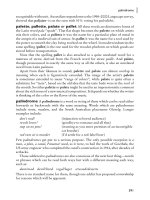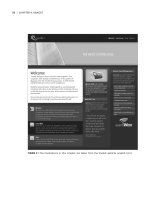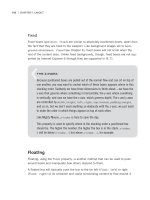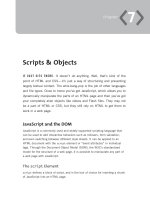The Best-Practice Guide to xHTML and CSS phần 8 potx
Bạn đang xem bản rút gọn của tài liệu. Xem và tải ngay bản đầy đủ của tài liệu tại đây (8.93 MB, 37 trang )
tAgs
|
1
tabindex—Where the element appears in the tab order of the page.
disabled—Disables the button. It must be used in the format
disabled=”disabled”.
name—Associates a name to the button so that it can be processed by a
form-handling script.
type—The button type. Values can be button (doesn’t do anything), submit
(default; submits the form when the button is selected), or reset (resets the
form).
value—An initial value that will appear as the button’s label.
Content
Text, block (not including form or fieldset), inline (not including input, select,
textarea, label, or button), or none.
Example
<button>Push my <strong>button</strong> baby</button>
Related Tags
input, form
<caption></caption>
A caption for a table. This should be placed directly after the opening table tag and
will be displayed above the table by default.
See Chapter 8, “Tables.”
Attributes
[Common attributes]
Content
Text, inline, or none.
•
•
•
•
•
•
1
|
AppendIx A: xhtml reference
Example
<table>
<caption>Animal groups</caption>
<! etc. >
</table>
Related Tags
table
<cite></cite>
In-line citation or reference to another source.
See Chapter 2, “Text.”
Attributes
[Common attributes]
Content
Text, inline, or none.
Example
<p>So I asked <cite>Bob</cite> about quotations and he said <q>I
know as much about quotations as I do about pigeon fancying</q>.
Luckily, I found ‘HTML Dog’ and it said…</p>
Related Tags
q, blockquote
<code></code>
Code, such as computer code.
See Chapter 2, “Text.”
•
tAgs
|
1
Attributes
[Common attributes]
Content
Text, inline, or none.
Example
<code>norahjonesisbland=true;</code>
Related Tags
samp, var, pre
<col />
Table column. Allows attributes to be applied to a table column. Must be used
within a colgroup element.
See Chapter 8, “Tables.”
Attributes
[Common attributes]
span—The number of columns the element applies to.
Note: There are other valid attributes (align, valign, char, charoff) but they are
presentational and so CSS should be used instead.
Content
Empty.
Example
<table>
<colgroup>
<col />
<col class=”alternative” />
•
•
•
0
|
AppendIx A: xhtml reference
<col />
</colgroup>
<tr>
<th>Cats</th>
<th>Dogs</th>
<th>Lemurs</th>
</tr>
<! etc. >
</table>
Here, the styles of the class “alternative” will be applied to the second column,
i.e., the second cell in every row.
Related Tags
colgroup, tr
<colgroup></colgroup>
Table column group. Allows attributes to be applied to a set of table columns.
See Chapter 8, “Tables.”
Attributes
[Common attributes]
span—The number of columns the element applies to.
Note: There are other valid attributes (align, valign, char, charoff) but they are
presentational and so CSS should be used instead.
Content
col elements or none
Example
<table>
<colgroup span=”2” class=”alternative”></colgroup>
•
•
tAgs
|
1
<tr>
<th>Cats</th>
<th>Dogs</th>
<th>Lemurs</th>
</tr>
<! etc. >
</table>
Related Tags
col, tr
<dd></dd>
A definition description that is paired with one or more definition terms within a
definition list.
See Chapter 6, “Lists.”
Attributes
[Common attributes]
Content
Text, block, inline, or none.
Example
<dl>
<dt>Dog</dt>
<dd>A carnivorous mammal of the family Canidae.</dd>
</dl>
Related Tags
dl, dt
•
|
AppendIx A: xhtml reference
<del></del>
An editorial deletion. Used in conjunction with ins when you want to track changes
in a document.
See Chapter 2, “Text.”
Attributes
[Common attributes]
cite—The location (as a URI) of an explanation of why the insertion was
made.
datetime—When the deletion was made (in the format of YYYYMMDD).
Content
Text, block, inline, or none.
Example
<p>Patrick was walking down the road when he saw a <del datetime=”2
0040329”>fluffy kitten</del><ins cite=””>giant
rabid snarling mutant saber-toothed goat</ins>.</p>
Related Tags
ins
<dfn></dfn>
Definition term.
See Chapter 2, “Text.”
Attributes
[Common attributes]—Note the title attribute is often used to describe the
definition.
•
•
•
•
tAgs
|
Content
Text, inline, or none.
Example
<p><dfn title=”Microsoft web browser”>Internet Explorer</dfn> is the
most popular browser used underwater.</p>
Related Tags
abbr
<div></div>
Division. A block-level element that groups together a multiple HTML elements.
Commonly used to apply CSS to a chunk of a page.
See Chapter 1, “Getting Started,” and Chapter 5, “Layout.”
Attributes
[Common attributes]
Content
Text, block, inline, or none.
Example
<div id=”content”>
<h1>How to make a falafel</h1>
<p>Buy a falafel seed and plant it in your garden.</p>
</div>
Related Tags
span
•
|
AppendIx A: xhtml reference
<dl></dl>
Definition list, which contains terms and descriptions.
See Chapter 6, “Lists.”
Attributes
[Common attributes]
Content
One or more dt or dd.
Example
<dl>
<dt>Cat</dt>
<dd>A little furry thing that purrs.</dd>
<dt>Dog</dt>
<dd>A big shaggy thing that barks.</dd>
</dl>
Related Tags
dt, dd, ul
<dt></dt>
A definition term that is paired with one or more definition descriptions within a
definition list.
See Chapter 6, “Lists.”
Attributes
[Common attributes]
Content
Text, inline, or none.
•
•
tAgs
|
Example
<dl>
<dt>Dog</dt>
<dd>A carnivorous mammal of the family Canidae.</dd>
</dl>
Related Tags
dl, dd
<em></em>
Emphasis.
Attributes
[Common attributes]
Content
Text, inline, or none.
Example
<p>You lookin’ at <em>me</em>?</p>
Related Tags
strong
<fieldset></fieldset>
A group of related form items.
See Chapter 9, “Forms.”
Attributes
[Common attributes]
Content
Text, legend, block, inline, or none.
•
•
|
AppendIx A: xhtml reference
Example
<form action=”whatever.php”>
<fieldset>
<! lots of form fields >
</fieldset>
<fieldset>
<! lots of form fields >
</fieldset>
</form>
Related Tags
form, legend
<form></form>
A form, allowing the sending of user-input data.
See Chapter 9, “Forms.”
Attributes
[Common attributes]
action (required)—Tells the browser where to send the form data when it is
submitted. This can be any URI, the destination of which will be a script
where the form data is initially processed.
method—Tells the browser how to send the form data. You have two options
here: get or post.
enctype—The MIME type used to encode the form data. The default value is
application/x-www-form-urlencoded, but this should be multipart/form-data when the
form contains a file input element.
accept—Which file-types (selected from a file input element) should be
accepted. This is a comma-separated list of MIME types.
accept-charset—Which character sets should be accepted. This is a comma-
separated list.
•
•
•
•
•
•
tAgs
|
Content
One or more block (not including form) or fieldset.
Example
<form action=”processor.php” method=”post”>
<! a whole load of form fields >
</form>
Related Tags
input, fieldset, label
<h1></h1>, <h2></h2>, <h3></h3>, <h4></h4>, <h5></h5>, <h6></h6>
Heading 1 (highest level heading) to Heading 6 (lowest level subheading). Headings
should be used in order and h1 used just once.
See Chapter 2, “Text.”
Attributes
[Common attributes]
Content
Text, inline, or none.
Example
<h1>Headings</h1>
<p>This is all about headings.</p>
<h2>The First Subheading</h2>
<p>The first subheading was called Bob. Bob was a figurine cleaner
in a past life.</p>
<h2>The Second Subheading</h2>
<p>The second subheading was called Labella. She used to be a
chimney sweep.</p>
<h3>Labella’s Chimney Sweeping</h3>
<p>Labella can still be persuaded to sweep chimneys for five beans a
chimney.</p>
•
|
AppendIx A: xhtml reference
<h2>The Third Subheading</h2>
<p>The third subheading was called John. He wasn’t particularly
interesting.</p>
Related Tags
p
<head></head>
The header of an HTML document where information about the document (rather
than page content) is placed.
You must use this element and it should be used just once. It must start immedi-
ately after the opening html tag and end directly before the opening body tag.
See Chapter 1, “Getting Started.”
Attributes
[I18n attributes]
profile—The location of information about the document. The value can be a
URI or a number of URIs separated by spaces.
Content
Must include single title. Can include base, link, meta, script, and style.
Example
<!DOCTYPE html PUBLIC “-//W3C//DTD XHTML 1.0 Strict//EN”
“ /><html xmlns=” xml:lang=”en”>
<head>
<title>Uncle Jack’s Sea Cow Farm</title>
</head>
<body>
<! A whole load of content >
</body>
</html>
•
•
tAgs
|
Related Tags
body, html, title
<html></html>
The root element that specifies that the content of the document is HTML. It
contains all of the remainder of the page information after the document type
declaration.
See Chapter 1, “Getting Started.”
Attributes
[I18n attributes]
xmlns (required)—The XML namespace. The value must be http://www.
w3.org/1999/xhtml.
Content
One head and one body.
Example
<!DOCTYPE html PUBLIC “-//W3C//DTD XHTML 1.0 Strict//EN”
“ /><html xmlns=” xml:lang=”en”>
<head>
<title>Uncle Jack’s Sea Cow Farm</title>
</head>
<body>
<! A whole load of content >
</body>
</html>
Related Tags
head, body
•
•
0
|
AppendIx A: xhtml reference
<img />
An image.
See Chapter 4, “Images.”
Attributes
[Common attributes]
src (required)—The location of the image file.
alt (required)—The alternative text of the image. This provides placeholder
text while the image is downloading. It also serves an important accessibility
task: It provides an “alternative” to the image for those who cannot see the
image itself.
longdesc—The location (in the form of a URI) of a description of the image.
An accessibility consideration, used for detailed images containing important
content (such as a map or a chart).
height—The height of the image (in pixels).
width—The width of the image (in pixels).
Note: border can also be used, although using CSS is preferable.
Content
Empty.
Example
<img src=”images/sifaka.jpg” alt=”Leaping sifaka” />
Related Tags
[none]
•
•
•
•
•
•
tAgs
|
1
<input />
A form field that can be represented as a text box, password text box, checkbox,
radio button, submit button, reset button, hidden field, image, file selection box, or
general button.
See Chapter 9, “Forms.”
Attributes
[Common attributes]
name—Provides an identifier for the element’s data.
type—The type of input. Values can be text (default), password, checkbox, radio,
submit, reset, hidden, image, file, or button.
value—The initial value. It is required when type is set to checkbox or radio. It
should not be used when type is set to file.
checked—For type=”checkbox” or type=”radio”, sets the initial state to selected.
Used in the format checked=”checked”.
maxlength—Sets a limit on the number of characters allowed in a text box.
src—For type=”image”, specifies the location of the image file.
alt—For type=”image”, specifies the alternative text of the image.
accept—For type=”file”, specifies which file types should be accepted. This is
a comma-separated list of MIME types.
disabled—Disables an element. Used in the format disabled=”disabled”.
readonly—Specifies that the value of the element cannot be changed. Used in
the format readonly=”readonly”.
accesskey—Associates a keyboard shortcut to the element.
tabindex—Specifies where the element appears in the tab order of the page.
Content
Empty.
•
•
•
•
•
•
•
•
•
•
•
•
•
|
AppendIx A: xhtml reference
Example
<form action=”somescript.php” />
<p>Do you like pie?</p>
<div>yes <input type=”radio” name=”pie” value=”yes”
checked=”checked” /></div>
<div>no <input type=”radio” name=”pie” value=”no” /></div>
<div>Your name: <input type=”text” name=”yourname” /></div>
<div><input type=”image” name=”submitimage” src=”someimage.gif”
/></div>
</form>
Related Tags
form, textarea, select, label
<ins></ins>
An editorial insertion. Used in conjunction with del when you want to track changes
in a document.
See Chapter 2, “Text.”
Attributes
[Common attributes]
cite—The location (as a URI) of an explanation of why the insertion was
made.
datetime—When the insertion was made (in the format of YYYYMMDD).
Content
Text, block, inline, or none.
Example
<p>Patrick was walking down the road when he saw a <del datetime=”2
0040329”>fluffy kitten</del><ins cite=””>giant
rabid snarling mutant saber-toothed goat</ins>.</p>
•
•
•
tAgs
|
Related Tags
del
<kbd></kbd>
Keyboard. Used to specifically suggest text that should be entered by the user.
See Chapter 2, “Text.”
Attributes
[Common attributes]
Content
Text, inline, or none.
Example
<p>Now type <kbd>banana</kbd>.</p>
Related Tags
code
<label></label>
Label for a form element (input, textarea, or select).
See Chapter 9, “Forms.”
Attributes
[Common attributes]
for—Associates the label to a form element when the value of for matches the
value of an element’s id attribute.
accesskey—Associates a keyboard shortcut to the element.
•
•
•
•
|
AppendIx A: xhtml reference
Content
Text, inline (not including label), or none.
Example
<label for=”email”>Email address</label><input type=”text”
name=”email” id=”email” />
Related Tags
input, textarea, select
<legend></legend>
Defines a caption for a fieldset. The element must appear directly after the open-
ing fieldset tag.
Attributes
[Common attributes]
accesskey—Associates a keyboard shortcut to the element.
Content
One or more text or inline.
Example
<fieldset>
<legend>Book Details</legend>
<! lots of form fields >
</fieldset>
Related Tags
fieldset
<li></li>
List item. An item in any ul or ol element.
See Chapter 6, “Lists.”
•
•
tAgs
|
Attributes
[Common attributes]
Content
Text, block, inline, or none.
Example
<ul>
<li>This</li>
<li>That</li>
<li>The other</li>
</ul>
Related Tags
ul, ol
<link />
Defines a link to an external resource such as a CSS file, a shortcut icon, or cus-
tomized navigation.
See Chapter 1, “Getting Started.”
Attributes
[Common attributes]
href—The target of the link.
charset—The character set of the target of the link.
hreflang—The language of the target of the link.
type—The MIME type of the target of the link.
rel—The relationship of the target of the link to the current page. Some uni-
versally understood values are shortcut icon and stylesheet.
rev—The relationship of the current page to the target of the link.
•
•
•
•
•
•
•
•
|
AppendIx A: xhtml reference
media—Which media the link is associated to. A value such as screen, print,
projection, braille, speech, or all can be used or a combination in a comma-sepa-
rated list.
Content
Empty.
Example
<link rel=”stylesheet” type=”text/css” title=”Some title” href=”/
somefile.css” />
<link rel=”alternate stylesheet” type=”text/css” title=”Some
alternative title” href=”/someotherfile.css” />
<link rel=”shortcut icon” href=”/favicon.ico” /><link rel=”next”
title=”Next page” href=”nextpage.html” />
Related Tags
head
<map></map>
A client-side image map. Used in conjunction with area to map links to certain
regions of an image.
Attributes
[I18n attributes]
[Events attributes]
id (required)—Uniquely identifies the element.
class—Used to reference the element with CSS.
title—A title for the element.
Content
One or more blocks or areas.
•
•
•
•
•
•
tAgs
|
Example
<map id=”atlas”>
<area shape =”rect” coords =”0,0,115,90” href =”northamerica.
html” alt=”North America” />
<area shape =”poly” coords =”113,39,187,21,180,72,141,77,117,86”
href=”europe.hmtl” alt=”Europe” />
<area shape =”poly” coords =”119,80,162,82,175,102,183,102,175,1
48,122,146” href =”africa.html” alt=”Africa” />
</map>
Related Tags
area
<meta />
Meta information. Used to provide information about the HTML page.
See Chapter 1, “Getting Started.”
Attributes
[I18n attributes]
content (required)—The meta information itself.
name—The name given to the meta information. Frequently used values of the
name attribute are “keywords” and “description,” but they can be absolutely
anything.
http-equiv—Used to define an “equivalent” HTTP header for the document
when name is not used.
scheme—Specifies how the value of content should be interpreted.
Content
Empty.
•
•
•
•
•
|
AppendIx A: xhtml reference
Example
<meta name=”keywords” content=”fruit, banana, orange, apple,
kumquat, cucumber” />
<meta name=”description” content=”News, reviews and opinion on all
things fruity.” />
<meta name=”author” content=”The Fruit Farmers Association of
Bujumburra” />
<meta name=”date” scheme=”Day-Month-Year” content=”12-01-99” />
Related Tags
head
<noscript></noscript>
Content to be used when scripts cannot be executed, through browser inadequacies
or user choice.
See Chapter 7, “Scripts & Objects.”
Attributes
[Common attributes]
Content
Block.
Example
<noscript>
<p>What? No JavaScript? Well what am I supposed to do now? Can’t you
get a new browser or something?</p>
</noscript>
Related Tags
script
•
tAgs
|
<object></object>
An embedded multimedia object such as a movie or a sound file.
See Chapter 7, “Scripts & Objects.”
Attributes
[Common attributes]
data—The location of the data for the object in the form of a URL.
type—The content type of the data specified by the data attribute. This basi-
cally lets the browser know what kind of file to expect.
declare—Specifies that the object is a declaration only. Must be used in the
format declare=”declare”.
classid—The location of the object in the form of a URL or Windows Registry
location.
codebase—The base location from which relative URLs specified in the classid,
data, and archive attributes should be taken.
codetype—The content type of the object.
archive—Resources relevant to the object. The value should be a URL or a
number of URLs separated by spaces.
standby—Text that will be displayed while the object is loading.
height—The height of the object (in pixels), just like in an img element.
width—The width of the object (in pixels), again, just like in an img element.
name—A name by which the object can be referenced.
tabindex—Where the element appears in the tab order of the page.
Content
Text, block, inline, param, or none.
•
•
•
•
•
•
•
•
•
•
•
•
•
0
|
AppendIx A: xhtml reference
Example
<object type=”blueberry/kumquat” data=”whatever.kmq”>
<param name=”tangy” value=”true” />
<param name=”segments” value=”9” />
<p>You don’t have the Kumquat plugin, so you won’t get any
juice.</p>
</object>
Related Tags
param
<ol></ol>
Ordered list, suggesting that each item is in some way lower or higher than the item
before or after it.
See Chapter 6, “Lists.”
Attributes
[Common attributes]
Content
One or more li.
Example
<ol>
<li>The first thing</li>
<li>The second thing</li>
<li>The third thing</li>
</ol>
Related Tags
li, ul, dl
•
tAgs
|
1
<optgroup></optgroup>
Option group. Defines a group of option elements in a select form field.
See Chapter 9, “Forms.”
Attributes
[Common attributes]
label (required)—Assigns a label to the option group.
disabled—Disables an element. It must be used in the format
disabled=”disabled”.
Content
One or more option.
Example
<select name=”book”>
<optgroup label=”Camus”>
<option>The Outsider</option>
<option>The Rebel</option>
<option>The Plague</option>
</optgroup>
<optgroup label=”Orwell”>
<option>Animal Farm</option>
<option>Nineteen Eighty-Four</option>
<option>Down and Out in Paris and London</option>
</optgroup>
</select>
Related Tags
option, select
<option></option>
Defines an option of a select form field.
See Chapter 9, “Forms.”
•
•
•









